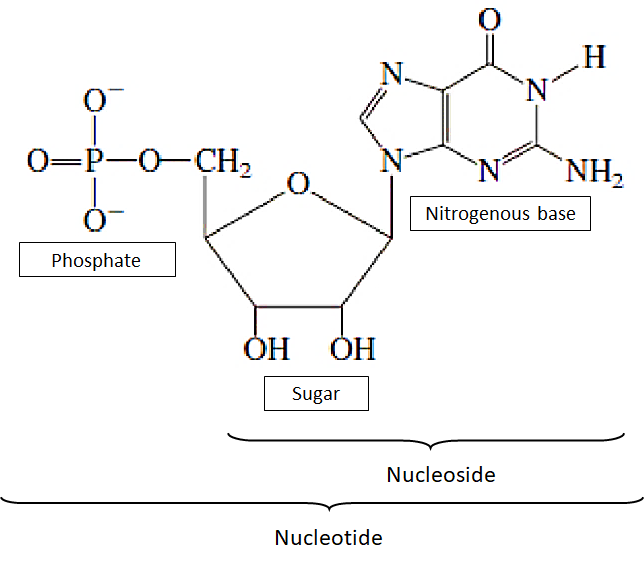
The three components of a nucleotide are _________, _________ and __________.
Answer
565.8k+ views
Hint: Nucleotides are organic molecules which consist of a phosphate and a nucleoside. They act as monomeric units of deoxyribonucleic acid (DNA) and ribonucleic acid (RNA) nucleic acid polymers, both of which are important biomolecules in all life forms on Earth.
Complete answer:
Three subunit molecules are composed of nucleotides: a nitrogen base (also known as nucleobase), a five-carbon sugar (ribose or deoxyribose), and a group of phosphates consisting of one to three phosphates. Guanine, adenine, cytosine, and thymine are the four nitrogenous bases in DNA; uracil is used instead of thymine in RNA.
At a fundamental, cellular level, nucleotides also play a central role in metabolism. In the form of nucleoside triphosphates, adenosine triphosphate (ATP), guanosine triphosphate (GTP), cytidine triphosphate (CTP), and uridine triphosphate (UTP), they provide chemical energy throughout the cell for the many cellular functions that require energy, including synthesis of amino acid, protein and cell membrane, movement of cell and cell parts (both internally and intracellularly), cellular functions. In addition, nucleotides (cyclic guanosine monophosphate or cGMP and cyclic adenosine monophosphate or cAMP) are involved in cell signaling and are incorporated into essential enzymatic reaction cofactors (e.g., coenzyme A, FAD, FMN, NAD, and NADP+).
Additional Information:
Three distinctive chemical subunits form a nucleotide: a five-carbon sugar molecule, a nitrogen base, two of which together are called a nucleoside, and a phosphate group. Depending on how many phosphates make up the phosphate group, a nucleotide is often called a "nucleoside monophosphate", "nucleoside diphosphate" or "nucleoside triphosphate" with all three joined.
Note: The nucleic acid is a major class of macromolecules that are present in both viruses and cells. The functions of nucleic acids are related to genetic information storage and expression. The information the cell requires to make proteins is encoded by deoxyribonucleic acid (DNA).

Complete answer:
Three subunit molecules are composed of nucleotides: a nitrogen base (also known as nucleobase), a five-carbon sugar (ribose or deoxyribose), and a group of phosphates consisting of one to three phosphates. Guanine, adenine, cytosine, and thymine are the four nitrogenous bases in DNA; uracil is used instead of thymine in RNA.
At a fundamental, cellular level, nucleotides also play a central role in metabolism. In the form of nucleoside triphosphates, adenosine triphosphate (ATP), guanosine triphosphate (GTP), cytidine triphosphate (CTP), and uridine triphosphate (UTP), they provide chemical energy throughout the cell for the many cellular functions that require energy, including synthesis of amino acid, protein and cell membrane, movement of cell and cell parts (both internally and intracellularly), cellular functions. In addition, nucleotides (cyclic guanosine monophosphate or cGMP and cyclic adenosine monophosphate or cAMP) are involved in cell signaling and are incorporated into essential enzymatic reaction cofactors (e.g., coenzyme A, FAD, FMN, NAD, and NADP+).
Additional Information:
Three distinctive chemical subunits form a nucleotide: a five-carbon sugar molecule, a nitrogen base, two of which together are called a nucleoside, and a phosphate group. Depending on how many phosphates make up the phosphate group, a nucleotide is often called a "nucleoside monophosphate", "nucleoside diphosphate" or "nucleoside triphosphate" with all three joined.
Note: The nucleic acid is a major class of macromolecules that are present in both viruses and cells. The functions of nucleic acids are related to genetic information storage and expression. The information the cell requires to make proteins is encoded by deoxyribonucleic acid (DNA).

Recently Updated Pages
A man running at a speed 5 ms is viewed in the side class 12 physics CBSE

State and explain Hardy Weinbergs Principle class 12 biology CBSE

Which of the following statements is wrong a Amnion class 12 biology CBSE

Two Planoconcave lenses 1 and 2 of glass of refractive class 12 physics CBSE

The compound 2 methyl 2 butene on reaction with NaIO4 class 12 chemistry CBSE

Bacterial cell wall is made up of A Cellulose B Hemicellulose class 12 biology CBSE

Trending doubts
What are the major means of transport Explain each class 12 social science CBSE

Which are the Top 10 Largest Countries of the World?

Draw a labelled sketch of the human eye class 12 physics CBSE

Explain sex determination in humans with line diag class 12 biology CBSE

Give 10 examples of unisexual and bisexual flowers

State the principle of an ac generator and explain class 12 physics CBSE




